Sept. 26th – Oct. 14th, Sensorium: Centre for Digital Arts and Technology at York University is teaming up with LAZNIA Centre for Contemporary Art in Gdansk, Poland to present Sensoria: The Art and Science of Our Senses.
“Sensorium is a research centre for creative inquiry and experimentation at the intersection of the media arts, performance, and digital culture. As a site for co-creation and shared critical reflection, Sensorium serves as a catalyst for examining how diverse media platforms enable multi-sensory perception and embodied experience, along with new modes of social engagement” says Joel Ong, the director of Sensorium.
“The exhibition will explore the dissociative potential of contemporary technologies on the senses, treating it not only as a social crisis but also an opportunity for creative play and experimentation” says Ong.
Sensoria aims to engage a conversation about the senses from a multi-sensory, multi-species perspective, engaging touch, smell, sound, and vision in a series of excitingly experiential works.
Ong explains that “for the past 4 years, curator Nina Czegledy has been meticulously building this exhibition and symposium in collaboration with the team at LAZNIA Centre for Contemporary Art. The pandemic’s repeated postponing of the installation had also provided time for her to discuss opportunities with myself.”
Ong and Czegledy together expanded Sensoria as a multi-site event experimenting with online/offline technologies to connect with participants across the world.
“International partnerships such as these help to catalyse knowledge sharing, provide supportive networks for emerging artists and scholars and encourage cultural exchange,” adds Ong.
Grace Grothaus, an artist presenting at Sensoria, holds a BFA from the Kansas City Art Institute, an MFA from UC San Diego, and is presently a PhD student in digital media at York University. Grothaus is an artist-scholar whose research is focused on environmental sensing and visualisation.
Grothaus describes their artwork titled, Sun Eaters, as “an installation in which renders bioelectricity visible as light through electrocardiography and custom electronics. Bioelectricity in humans results in a rhythmic pulse we understand as a heartbeat, and in plants, it is rendered in a much different wave pattern. Sun Eaters combines measurements from participants with that of a tree installed within the gallery for a meeting across species. If you can visibly see your heart pulse together with a tree, will you experience a different level of connection with it?”
Csenge Kolozsvari, an artist performing and providing a workshop at Sensoria, says that audiences can “expect a real inquiry into what other modes of perception we can find collectively, which allows for taking in the world in its complexity, its inherent vitality through somatic experience, and following philosophical lines of thoughts and imaginary technologies.”
Kolozsvari’s interdisciplinary artistic practice includes video, sound and performance, listening to different temporalities of movements, and cultivating somatic practices as ways of making sense of the world.
“My work brings embodied and touch-based practices into the visual art context with the urgent conviction that together, these universes can energise social change: inclusive, ecological and creative collaborative action” says Kolozsvari.
Sensoria’s Toronto exhibition, held at the Gales Gallery, will launch on Sept. 26 with an opening reception from 5pm to 6:30pm and will be up until October 14. All aspects of the symposium will be presented virtually, to allow both in-person engagement in Toronto and virtual presence in Gdańsk, among others. To learn more about the Sensoria schedule and to register, click here.

